By Darla Pompilio, (610) 847 5422, Your Tasks, Our Time
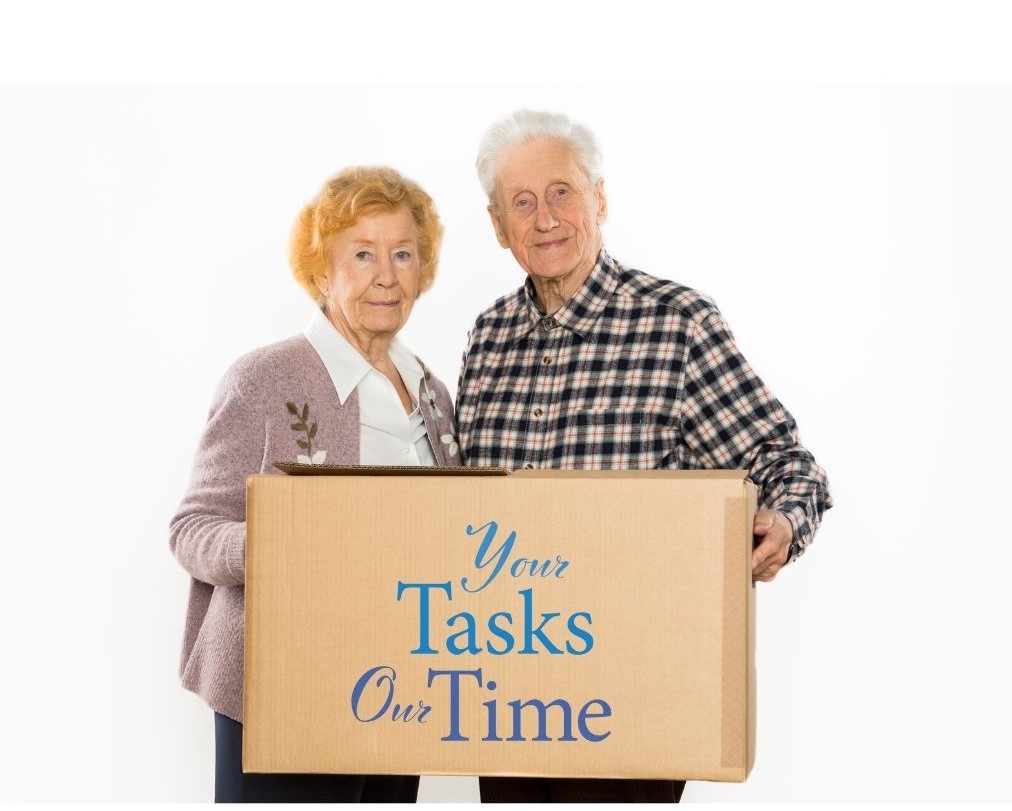
Do you have a parent or senior in your life that could benefit from downsizing their home but
you’re not sure how to approach the discussion? The topic of downsizing can be a difficult for
some. They may have to part with items that have memories attached. Or it may make them
feel like they are losing a piece of themselves. Below are some key aspects to ensure you have a
supportive and respectful discussion with the seniors in your life.
Before You Begin the Conversation
Before you start the conversation with your loved one, keep a few things in mind.
Be Respectful and Non-Judgmental
A Senior’s possessions represent a lifetime of memories. Dismissing their value as worthless is
equal to dismissing the senior’s value.
Don’t Lecture
Most seniors will respond well if you share your concerns and express your desire for them to
be in a safe and comfortable environment. It’s not about forcing them to get rid of things, it’s
about helping them to live their best life.
How to Begin the Conversation
How you start the conversation, and the tone you use, can impact the discussion either positively or negatively. Come from a place of support and love so they understand your desire to help them. Below is a list of questions you can use to get the conversation started.
Open-ended questions will be better to gain more information.
During the Conversation
Getting the conversation started is a step in the right direction. Keeping the conversation going in a positive direction is just as important. Remember these key points as you progress through your discussion.
Simply Listen
This is probably the most important step in the process. When seniors let go of their possessions, it often feels like a loss of control. By listening to their wants, needs and desires, you’re helping to ensure that they are maintaining control.
Ask Questions
Allowing seniors to tell stories about the past as you sort through their possessions can help ease some of the anxiety during the process of letting go.
Pick Your Battles
Arguing over every item is going to end with lots of hurt feelings and no progress. Letting go takes practice and patience. Keep reminding your loved one of the ultimate goal … for them to live their best life. It will get easier as they become more comfortable with letting go.
This process won’t be done overnight. It’s not uncommon to go through an entire home 2 to 3 times to achieve the desired goals. So be kind. Be patient. And remember, you may be in a similar situation yourself in the future.
By Kelly Galfand, JOY IN YOUR SPACE, 610-896-6896
My role as organizer usually involves helping people:
• live with less
• have more within easy reach
• love what they store.
One popular area I organize is wardrobe closets. Sometimes I’m hired to fix a physical problem; I solve storage challenges. Sometimes I am the necessary support as someone decides:
• what to keep
• where to donate or sell
• how to let clothes go.

In my experience, even when someone commits to trimming their wardrobe, there is one item they want to get rid of but (in their words) “can’t!” In these situations, what’s really behind their “can’t” is guilt.
When I hear a closet client say “I can’t get rid of this,” I know the clothing in question was either expensive, a gift, or it holds sentimental value.
• If the item was expensive… and they haven’t worn it (ever or enough), the struggle is about throwing good money away. But honestly, they’re wasting more money by storing this item. Waiting too long to resell something is not smart; the resale market pays more for recent purchases.
• Check out resale avenues like TheRealReal, PoshMark, Clothes Mentor, Plato’s Closet, and ThredUp depending on the item’s value.
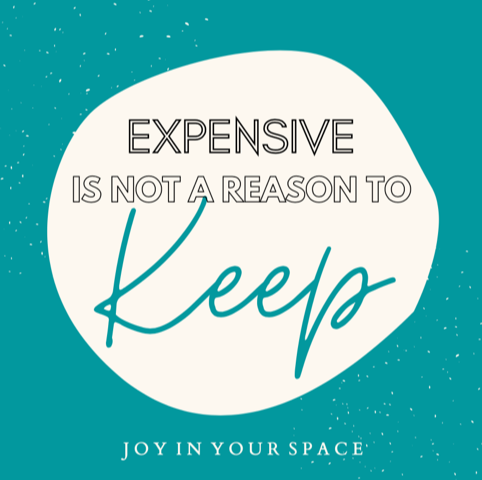
• If the item was a gift… from someone they love, their love for the person is getting in the way of their ability to decide what they want in their life. They sometimes think that letting the item go is akin to rejecting the gift-giver’s love, kindness, or generosity. Trust me, your favorite aunt knows you love her even if you don’t love the winter hat she gave you. I always reassure clients that no one gives a gift in order to burden the recipient. A recipient’s only responsibility is to be gracious in accepting the gift.
• —You can always donate the item or its value to a charitable organization the gift-giver supports to lessen the pain of letting the item go from your life. Let it be a gift that keeps on giving — to someone else!
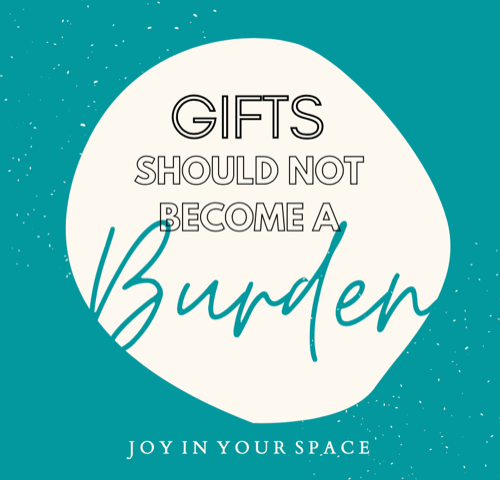
• If the item holds memories it will fall into one of two categories:
• Clothing from the person’s own life (even if it was someone else’s at some point)
When I come across these sentimental clothes, the first question I ask is: Will you still wear it? If the answer is “yes,” it can stay.
If the answer is “no,” then I suggest the t-shirt, wedding gown, or cheerleading skirt move to a spot more suitable to memories and nostalgia.
• Clothing that holds memories may have belonged to a deceased loved one. I help people navigate these sensitive areas often. What I counsel, is to keep only the sweatshirts, t-shirts, or hats that meant something to the departed and mean something still to you if you have room for it.
If it’s something you aren’t going to wear, display it to honor it in some way. Shadow boxes are wonderful conversation pieces and visual reminders of our ancestors’ legacies.
To me, your adored Uncle’s memory does not hinge on a single t-shirt…not even on his entire t-shirt collection. I recommend that if you let items go from your life (that belonged to someone you loved) decide how you will remember this person (in thought or deed) once you let the item go. Then be intentional in keeping their memory alive.
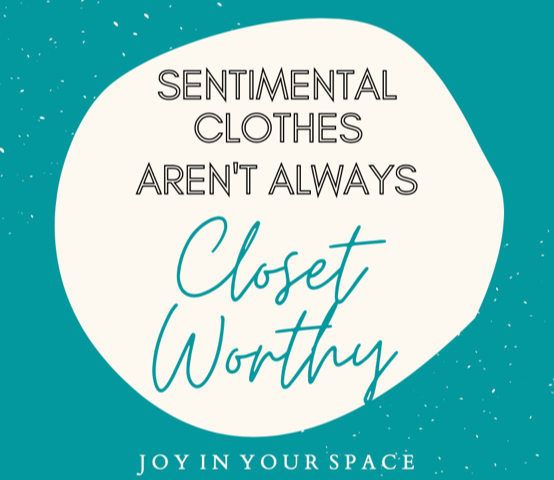
Day 365 + ???? (who’s counting) of the pandemic and it seems like everyone is decluttering. We’re all trying to hold true to our reoccurring New Year’s Resolution to ”Get Organized.” Getting Organized can mean different things to us but it usually involves some sorting and culling of categories of stuff.
In our experience, there are always 3 decision buckets your stuff will fall into:
Our NAPO colleague, Barbara Hemphill, coined this brilliant definition: Clutter is Postponed Decisions.™ Clutter builds when we postpone decisions about:
• Do I really love it?
• Will I use it?
• Does it fill a void in my life?
• If I’m keeping it, where should it live?
While you do need to decide about your stuff, you do NOT want to stop the decluttering process to ponder each individual item.
Our time-saving advice is DEFER your decision for the “maybes” and “I don’t knows.”
These tricky decisions deserve attention — but NOT while you’re in the initial stages of rapid-fire, gut reactions to your stuff.
If you stop your intuitive process of deciding Yes, No, Maybe you won’t get through the whole category of stuff and you won’t see visible signs of progress. This will feel depressing and probably halt the whole decluttering process.
Follow our advice and schedule time with yourself — on a separate day — when your mind is fresh and you’ll taste sweet success. Technically, it’s called time chunking. In practice:
• One organizing session is dedicated to quick, visceral decisions.
• Another for contemplative, thoughtful and reasoned thinking.
Permission granted to defer your decisions on all of your “maybes” and “I don’t knows” — not because pushing off until tomorrow is a winning strategy. Permission granted because setting aside the necessary time to consider what deserves a place and space in your life is worthy of your full attention. In this case, deferring the decision is a smart move.
Sentimental objects are one of the most challenging categories for professional organizers to help clients with. This is especially true with objects related to family history, such as:
Photographs,
Newspaper clippings,
Family history documents (letters, journals, diaries, invitations, etc.),
Education related (book reports, college papers, graduation diplomas, etc.),
Civil records about family members (marriage records, immigration records, birth/death certificates, etc.)
Photos, diaries, papers, trophies…these are all critical elements of your family legacy. They tell the story of important family members, and are the fabric of what binds families together. Personally, I am not an advocate of throwing this all away. On the other hand, how can anyone benefit if these materials are stashed away in the attic, basement, or closet?
The first step to any family history project is taking an inventory of what you have. Even if your project is simply tidying your family history boxes, you will be happy you did it. And I promise, your children will thank you!
Take some time to go through each box carefully and understand what is in them. It’s almost always the case we find things we had completely forgotten about. And it’s not at all uncommon to find objects we thought were lost. Once you know what you have, it will be much easier to figure out what to keep, and how to organize it all.
One complaint I hear frequently is that people don’t really know what to do with these materials. They accumulate and accumulate, taking up more room than you ever would have wanted. The fear of the materials being damaged, and frustration that nothing productive is being done with them, causes most people to feel anxious, along with a good measure of guilt.
Organizing family history materials allows us to honor family members and declutter. As I mentioned, I am not a fan of throwing these materials away. BUT, you’ll be surprised how much space is being taken up by duplicates, damaged papers/photos, old frames, and photos of people you don’t know—all of which can all be thrown away.
And watch out for newspaper clippings! Newspaper paper does not last. Not only that, it can damage other materials it comes into contact with.
The advent of online publishing has made printing books in small print runs very affordable. Imagine having a book of all your parents’ correspondence, and giving a copy to each of your children. Or imagine assembling all the civil records about your ancestors so the whole family can have a richer understanding of its roots and history. All you need is a scanner and a little patience. If you don’t have the time, there are many scanning services which can do this for you. The Association of Professional Photo Organizers is also a great place to find someone locally who can do this.
Once scanned, it’s time to select an online book publisher. There are many to choose from. Two of my favorites are Blurb and Mixbook. Mixbook in particular has some great layouts just for family history projects. Be sure to wait for a sale! Both these sites frequently offer significant discounts.
It probably won’t surprise you to learn that these books become instant family heirlooms. They make terrific gifts for important birthdays or around the holidays.
If you run into a hiccup while organizing, scanning, or making your book, feel free to give me a call. I’m always happy to answer questions. Good luck with your family history project!
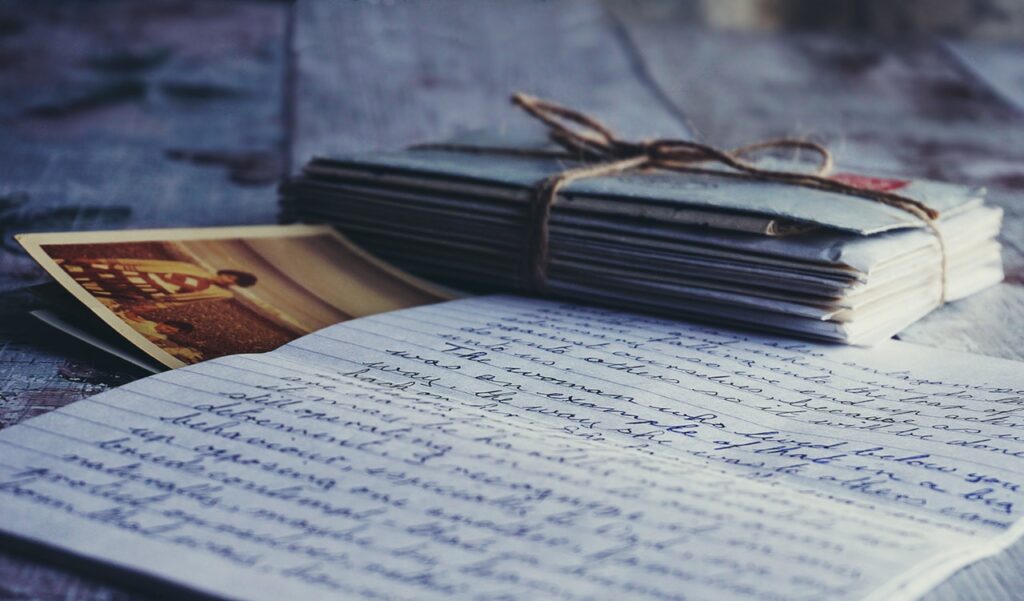
People often wonder about the possible value of items they have accumulated over many years. These items are often viewed as “treasures” which may have significant resale value. Finding the “treasures” among their possessions often surfaces when:
 Many of the items accumulated may not have been purchased by the current owner including inherited items, gifts received, or collections of a spouse who has passed away.
Many of the items accumulated may not have been purchased by the current owner including inherited items, gifts received, or collections of a spouse who has passed away.
People often have a sense of the value of some of their valuables. However, in many cases the values are from past information or are based on a retail price that does not represent current resale value.
Many people research and try their hand at determining resale values. The internet is the most common resource used. There is a great deal of information available on the internet, so much so, that it can become overwhelming. However, it is possible to get a sense of what to expect in the current market. A few resources which are helpful, free, and fairly easy to use are EBay, Live Auctioneers, and Invaluable. Each of these resources provide a history of the selling price of items which have been offered through their sites. They provide the sales history with no charge once you have registered (registration is free). When researching items, it is important to look at the selling price results of the same or similar items. Using the asking price is not reliable because the seller can ask any price they would like for an item. Therefore, it is the selling price which provides a more accurate measure of resale value.
Often, another challenge is properly identifying the item to be valued. There are reproductions or copies which can be difficult to differentiate from originals. There are maker marks and signatures which are difficult to find and read. I have had clients get extremely excited about an item they saw on Antiques Road Show that was worth many thousand of dollars and looked just like the one they own. In most cases, there are subtle differences and their item is of much less value.
It is helpful to have the help of a trained eye. There are professional resources available to help identify the value of potential treasures:
A common question I receive relates to collectible plates and other collectible items which have been purchased on late night television throughout the decades. In most cases, there is little or no value to these items. When there are many of something sold to many collectors, the value does not often increase. The resale market is driven by supply and demand. When there is a large supply of collectible items made for collecting, there is rarely enough demand to make them valuable.
 Finding treasures is an adventure which is rewarding and disappointing at times. Enjoy the adventure and I wish you good luck as you treasure hunt.
Finding treasures is an adventure which is rewarding and disappointing at times. Enjoy the adventure and I wish you good luck as you treasure hunt.
Personal property is “in motion” when there is a need to deal with your movable personal possessions. Items include furnishings, art, antiques, jewelry, and collections — often referred to as “stuff.”
What puts Personal Property in Motion?
• Moving & down-sizing living space
• Selling a local home to move full-time to a vacation home
• Inheriting items when your home is already full
• Deciding to sell a personal collection
• Making a decorating/design change or upgrade
• Getting organized to deal with stuff which has accumulated over the years
• Settling an estate
Suggestions for dealing with emotions when Property is in Motion
• Pictures can help retain the memory of items. Remembering special rooms, spaces, items, and collections through picture albums can help minimize the sense of loss. The pictures, when stored and retrieved electronically, take up no physical space.
• Providing family and friends with the opportunity to acquire items helps in many cases. Passing along sentimental items, in this way, often feels good.
• Recognize it is now normal when family and friends are not interested in many of your furnishings and treasures. Unfortunately, I see this in the majority of people I have worked with in recent years. It helps to not take it personally. When this happens, it is time to sell, donate, or dispose.
Identifying and selling valuable personal property:
• Unfortunately, what you or your family paid for items does not matter to buyers.
• The buyers are generally significantly younger than the sellers. Current market value is driven by what buyers demand.
• When you look to sell valuables directly to a buyer, knowing the current market value is helpful in setting and negotiating a fair price.
• Auctions are an efficient way to deal with significant amounts of personal property in motion efficiently; there are auctions available at every level.
• Higher-end auction houses are an efficient resource in identifying valuable items and their market value; there is generally no charge for this service.
• When selling valuables at auction, it is important to use an auction house which regularly offers similar items. They will have established clientele and attract strong bidders.
Very often, a handful of the most valuable personal property items are worth as much as everything else (you’d hoped to sell) combined. When this happens, half of the financial work in handling the property in motion is complete, simply by identifying and selling the most valuable items.
The process of dealing with property “in motion” brings out emotion. There are memories attached to belongings which connect us to our family, friends, and occasions throughout our lives. While the process may have emotional ups and downs, it feels good when it is complete. I wish you well.
Click on the title above to learn more about the featured author.